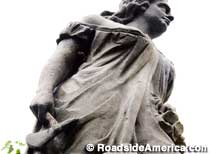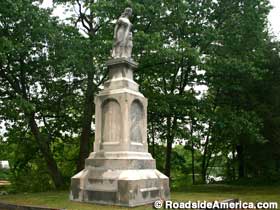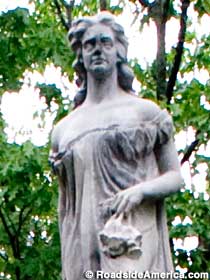
Hannah Duston Massacre Site Statue
Boscawen, New Hampshire
According to early historian Cotton Mather, Hannah Duston (also spelled "Dustin"), her six-day old baby Martha, and her nurse Mary Neff were kidnapped by Native Americans on March 15, 1697. After several days on the run north into New Hampshire, the captors and prisoners ended up here, on a small island. Somewhere along the way one of the kidnappers grabbed baby Martha and smashed her to death against a tree.

Hannah, enraged, waited until her captors were asleep, grabbed a tomahawk, and began killing them, aided by the nurse and a 14-year-old boy. By the time that they were through, 10 of the 12 kidnappers lay dead. Hannah collected the scalps as proof of her deed (and to collect a scalp bounty) and went home.
177 years passed. By 1874 New Hampshire had become part of the U.S., and Hannah had become an object of civic pride: the "Granite State Heroine." Of all of the women who had ever lived in America, Whackin' Hannah was the first to get a statue.
It stands on the spot where her massacre occurred, an impressive 35 feet tall. Its location on an otherwise undeveloped island adds to its majesty, but it also makes it an easy target for vandals. Hannah's pedestal has been sprayed with graffiti and splattered with red paint, and her nose has been broken, probably by a bullet. Her expression, despite the facial damage, is one of resolve, or maybe blank shock. But it seems ill-suited to a woman who has just scalped ten people.

In her right hand is a hatchet, in her left, a tangled mass of scalps, which could be mistaken for a bouquet of wilted flowers if you didn't know what they were. The monument's inscription poetically dismisses her victims as "the war whoop tomahawk faggot and infanticides."
This statue is less memorable overall than the angry Hannah Duston statue in her hometown of Haverhill, Massachusetts. But it does have the scalps (which the other lacks), and it is bigger.
Don't visit at dusk or dawn in the warm weather months unless you want to be eaten alive by mosquitoes.





